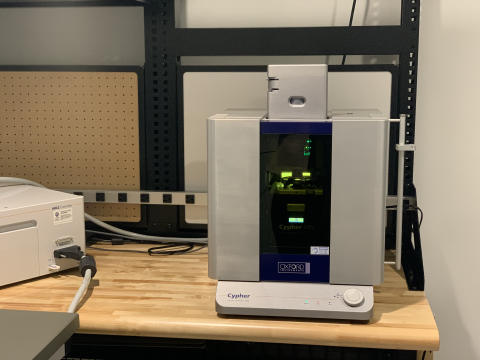
Oxford Instruments Asylum Research is holding a day-long, in-person workshop with morning presentations (12-0168 and on zoom) and afternoon hands-on applications topics (12-0145). Please join us for a day of getting more familiar with the Asylum Research AFMs at MIT.nano.
What can I measure with an Atomic Force Microscope?
Advanced AFM Modes for Materials Characterization
LOCATION: 12-0168 and Zoom
TIME: 9:30AM - 10:30AM
SPEAKER: Ted Limpoco, Ph.D., Senior Applications Scientist, Oxford Instruments Asylum Research
Atomic force microscopes (AFMs) are fundamentally visualization tools with the ability to routinely resolve topographic features of surfaces at the nanometer scale. At its highest performance, AFMs can resolve even atomic lattices and point defects. AFMs also use a mechanical probe, such that it essentially “touches” the surface, so we can obtain more information than just topography. Contact or proximity to the surface enable us to measure material properties, such as mechanical, electrical, and magnetic properties. Since the probe tip is very small, we can get very local information, mapping this on surface topography with nanometer detail. AFMs have thus become an indispensable tool in nanotechnology research.
In this presentation, we will survey advanced AFM modes that measure properties such as Young’s modulus, adhesion, and viscoelastic response (force curves, FFM, AMFM, DART-CR); current (CAFM); surface potential and work function (KPFM or SKPM); electric charge and magnetic field (EFM and MFM); capacitance, as well as dopant levels and type (SCM); and, finally, electromechanical or piezoelectric response (DART™-PFM). In the process, we will touch on advances in multi-frequency modes (DART™, AM-FM), modern methods of cantilever excitation (blueDrive™ photothermal excitation), capturing biomolecular dynamics (video-rate scanning), and imaging under environmental control.
These various measurement modes, combined with its ultrahigh resolution, highlight the strength and versatility of AFMs in materials characterization and nanotechnology research.
Overview of JupiterXR and Cypher S ES/ VRS AFMs at MIT.nano
LOCATION: 12-0168 and Zoom
TIME: 10:30AM-11:30AM
SPEAKER: Ryan Fuierer, Ph.D. Oxford Instruments Asylum Research
A general overview of the hardware components of both the JupiterXR and Cypher AFMs will be presented. The anatomy of each AFM system will be described, along with the proper handling and identification of tool components including probe holders, sample cells and scanners. A general overview of the AFM software navigation will also be presented.
Break: 11:30AM-12:30PM
Afternoon hands-on workshop for most common applications using the Cypher AFM
LOCATION: 12-0145
PRESENTER: Ted Limpoco, PhD. Oxford Instruments Asylum Research
Time Slot 1 (12:30PM-1:30PM): Topography Best Practices
Description: This segment will offer a hands-on approach for contact mode and AC (Tapping) mode techniques, and support the value of monitoring the AC phase signal during imaging to control tip sample forces.
Time Slot 2 (1:30PM-2:30PM): PiezoResponse Force Microscopy (PFM)
Description: This segment will feature examples of techniques associated with piezo force microscopy, specifically how dual frequency AC resonant tracking PFM eliminates topographic crosstalk while maintaining optimal signal to noise in PFM imaging.
Time Slot 3 (2:30PM-3:30PM): NanoElectrical Techniques: cAFM, EFM, KPFM
Description: This segment will provide hands-on examples of common nanoelectrical best practices for techniques such as conductive AFM, Electrostatic Force Microscopy and Kelvin Probe Force Microscopies.
Time Slot 4 (3:30PM-4:30PM): Nanomechanical mapping techniques
Description: This segment will feature an overview of the nanomechanical mapping modes on the Asylum Research AFMs, and when to use them. This will include AM-FM viscoelastic imaging, fast force mapping, and contact resonance imaging techniques.
